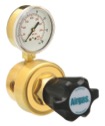

Recently, I was asked to visit a customer to troubleshoot what they thought was a leaking regulator. The customer could hear—and they believed they felt—gas weeping out of the bonnet vent port of their regulator. The bonnet vent port is located on the bonnet of the regulator and is either a 1/4” or 1/8” NPT female thread. It allows for the customer to install tubing to pipe away toxic or flammable or asphyxiant gases if the regulator’s diaphragm fails, which can occur but is fortunately uncommon.
The customer brought me to the location where the regulator is installed and was providing gas to the application. He then pointed out that he could hear the gas coming out of the bonnet vent port and that, when he would put his finger over the vent port hole, it would deaden the sound, giving the customer the impression that gas was leaking out of the regulator. What the customer was actually experiencing was harmonic resonance.
Harmonic resonance sometimes occurs in metal diaphragm pressure regulators with the combination of (in this case) low inlet pressure 100 psig and low outlet pressure 60 psig (can also be high inlet pressure, very low outlet pressure and a low-density gas). The regulator’s thin metal diaphragm is torqued into place between the body and bonnet of the regulator, acting much like the cone of a speaker, while the bonnet cavity acts like a speaker case. Together they amplify the sound of the gas traveling through the orifice past the main valve, resulting in what’s often perceived as a hiss.
If the regulator was truly leaking past the diaphragm, the customer would have experienced gas leaking through all the connections on the bonnet and a great deal of pressure downstream from the regulator.
To verify a leak, simply isolate the regulator by closing an inlet valve and an outlet valve. If the regulator is leaking, the pressure on the gauge(s) will drop from the set point to zero.

Another quick means of verification is to cover the bonnet port with a finger to see if the sound goes away. You can always double check by putting leak solution over the weep hole (the much smaller hole on the bonnet) to see if the regulator is leaking. The small weep hole may not always show a leak. The best way is to put a leak detector over the port. The leaking gas will always take the path of least resistance. If the sound coming from your regulator turns out to be harmonic resonance, rest easy—it’s not going to damage the regulator.
In the case of my customer, the harmonic resonance concerned him and he wanted to make it stop. To stop the noise you can either adjust the inlet pressure to a higher set point (maybe just a couple of psi) or adjust the delivery pressure up or down (again just a couple of psi) until the noise subsides. If the regulator has a needle valve, adjusting the valve can also assist in eliminating or reducing the resonance.
The lowest resonant frequency of a vibrating object is called its fundamental frequency. Most vibrating objects have more than one resonant frequency and those used in musical instruments typically vibrate at harmonics of the fundamental. A harmonic is defined as an integer (whole number) multiple of the fundamental frequency. Vibrating strings, open cylindrical air columns and conical air columns will vibrate at all harmonics of the fundamental. Cylinders with one end closed will vibrate with only odd harmonics of the fundamental. Vibrating membranes typically produce vibrations at harmonics, but also have some resonant frequencies which are not harmonics. It is for this class of vibrators that the term overtone becomes useful—they are said to have some non-harmonic overtones.